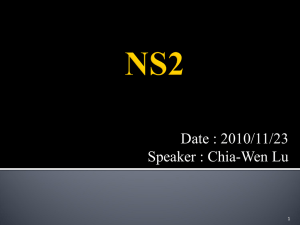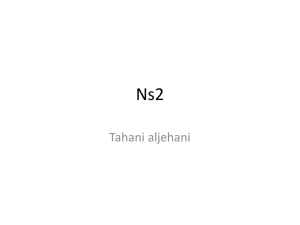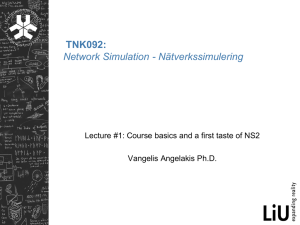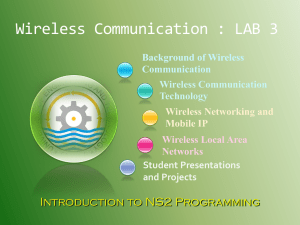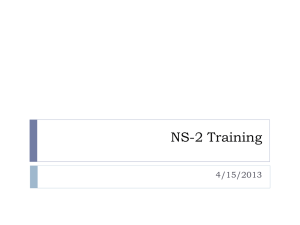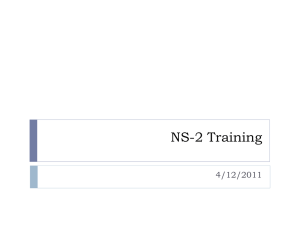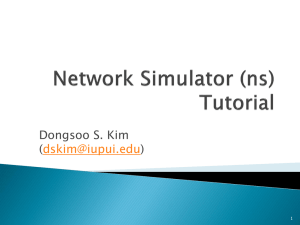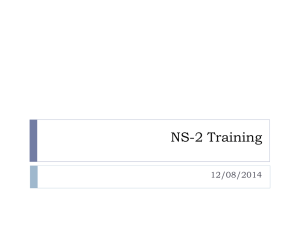NS2
advertisement
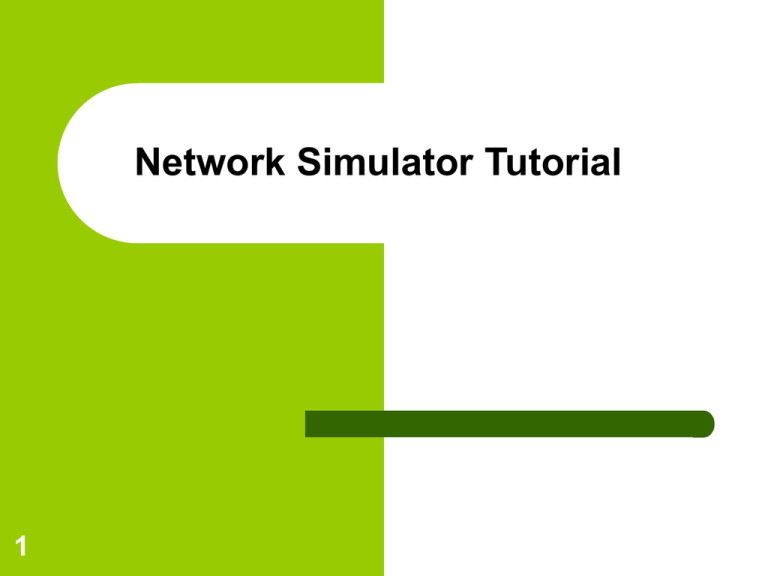
Network Simulator Tutorial
1
Network Simulation *
Motivation:
Overview:
Learn fundamentals of fundamentals of discrete
evaluating network
event simulation
performance via
ns-2 simulation
simulation
2
What is simulation? *
system boundary
exogenous inputs
to system
(the environment)
system under study
(has deterministic rules
governing its behavior)
“real” life
observer
program boundary
psuedo random inputs
to system
(models environment)
3
computer program
simulates deterministic
rules governing behavior
observer
“simulated” life
Why Simulation? *
4
real-system not available, is complex/costly or
dangerous (eg: space simulations, flight simulations)
quickly evaluate design alternatives (eg: different
system configurations)
evaluate complex functions for which closed form
formulas or numerical techniques not available
Simulation: advantages/drawbacks*
advantages:
–
–
–
–
drawbacks:
–
–
–
–
–
5
sometimes cheaper
find bugs (in design) in advance
generality: over analytic/numerical techniques
detail: can simulate system details at arbitrary level
caution: does model reflect reality
large scale systems: lots of resources to simulate
(especially accurately simulate)
may be slow (computationally expensive – 1 min real
time could be hours of simulated time)
art: determining right level of model complexity
statistical uncertainty in results
The evaluation spectrum*
6
Numerical models
Simulation
Emulation
Prototype
Operational system
Programming a simulation*
What ‘s in a simulation program?
simulated time: internal (to simulation program) variable that
keeps track of simulated time
system “state”: variables maintained by simulation program
define system “state”
–
events: points in time when system changes state
–
–
7
e.g., may track number (possibly order) of packets in queue, current
value of retransmission timer
each event has associate event time
e.g., arrival of packet to queue, departure from queue
precisely at these points in time that simulation must take action
(change state and may cause new future events)
model for time between events (probabilistic) caused by external
environment
Simulator Structure*
simulation program maintains and
updates list of future events: event list
Need:
well defined set of events
for each event: simulated system action,
updating of event list
8
Simulator Block Diagram*
initialize event list
get next (nearest future)
event from event list
time = event time
process event
(change state values, add/delete
future events from event list)
update statistics
n
9
done?
NS2 Outline
10
What is it?
How do I get it?
How do I use it?
How do I add to it?
Documentation
What is NS2?
Network Simulator
A package of tools that simulates behavior of
networks
–
–
–
11
Create Network Topologies
Log events that happen under any load
Analyze events to understand the network
behavior
Creating Topologies
n1
5Mbps,
10ms
300Kbps,
100ms
n5
n3
500Kbps,
50ms
n4
n2
2Mbps,
20ms
12
300Kbps,
100ms
n6
Creating Topologies
Nodes
–
–
Links
–
–
13
Set properties like queue length, location
Protocols, routing algorithms
Set types of link – Simplex, duplex, wireless,
satellite
Set bandwidth, latency etc.
Done through tcl Scripts
Observing Network Behavior
Observe behavior by tracing “events”
–
time
14
Eg. packet received, packet drop etc.
Src Dst IP
Address, Port
Observing Network Behavior
NAM:
–
–
15
Network Animator
A visual aid showing how packets flow along the
network
Outline
16
What is it?
How do I get it?
How do I use it?
How do I add to it?
Documentation
How Do I get NS2?
NS already Installed for us at:
–
/u/yzhang/ns-allinone-2.27-oolsr-0.99.15/ns-2.27
NAM already installed at :
–
–
/u/yzhang/ns-allinone-2.27-oolsr-0.99.15/nam1.10
Add this to the PATH variable of your shell
For tcsh, add the following lines to your ~/.cshrc file
setenv PATH “/u/yzhang/ns-allinone-2.27-ooslr-0.99.15/ns-2.27:$PATH”
setenv PATH “/u/yzhang/ns-allinone-2.27-ooslr-0.99.15/nam1.10:$PATH”
17
Outline
18
What is it?
How do I get it?
How do I use it?
How do I add to it?
Documentation
How Do I use it?
19
Creating a Simple Topology
Getting Traces
Using NAM
Basics of using NS2
Define Network topology, load, output files in
Tcl Script
To run,
$ ns simple_network.tcl
20
Internally, NS2 instantiates C++ classes
based on the tcl scripts
Output is in form of trace files
A simple Example – Creating the
topology
Bandwidth:1Mbps
Latency: 10ms
n1
21
n2
Creating the topology
#create a new simulator object
set ns [new Simulator]
#open the nam trace file
set nf [open out.nam w]
$ns namtrace-all $nf
#define a 'finish' procedure
proc finish {} {
global ns nf
$ns flush-trace
#close the trace file
close $nf
#execute nam on the trace file
exec nam out.nam &
22
exit 0
}
Creating the topology (Contd)
#create two nodes
set n0 [$ns node]
set n1 [$ns node]
#create a duplex link between the nodes
$ns duplex-link $n0 $n1 1Mb 10ms DropTail
23
Adding traffic
1Mbps,10ms
n1
n2
udp
null
cbr
node
agent
Packet Size: 500 bytes
rate: 800Kbps
source
link
cbr traffic
0.0
0.5
4.5
5.0
time
24
Putting it together..
#create a udp agent and attach it to node n0
set udp0 [new Agent/UDP]
$ns attach-agent $n0 $udp0
#Create a CBR traffic source and attach it to udp0
set cbr0 [new Application/Traffic/CBR]
$cbr0 set packetSize_ 500
$cbr0 set interval_ 0.005
$cbr0 attach-agent $udp0
#create a Null agent(a traffic sink) and attach it to node n1
set null0 [new Agent/Null]
$ns attach-agent $n1 $null0
#Connect the traffic source to the sink
$ns connect $udp0 $null0
#Schedule events for CBR traffic
$ns at 0.5 "$cbr0 start"
$ns at 4.5 "$cbr0 stop"
#call the finish procedure after 5 secs of simulated time
$ns at 5.0 "finish"
#run the simulation
$ns run
25
A second Scenario * (from NS by
Example)
Taken from NS by
Example by Jae Chung
and
Mark Claypool
26
A second Example (From NS by
Example)
#Create a simulator object
set ns [new Simulator]
#Define different colors for data flows (for NAM)
$ns color 1 Blue
$ns color 2 Red
#Open the NAM trace file
set nf [open out.nam w]
$ns namtrace-all $nf
27
#Define a 'finish' procedure
proc finish {} {
global ns nf
$ns flush-trace
#Close the NAM trace file
close $nf
#Execute NAM on the trace file
exec nam out.nam &
exit 0
}
A Second Scenario (Contd.)
#Create four nodes
set n0 [$ns node]
set n1 [$ns node]
set n2 [$ns node]
set n3 [$ns node]
#Create links between the nodes
$ns duplex-link $n0 $n2 2Mb 10ms DropTail
$ns duplex-link $n1 $n2 2Mb 10ms DropTail
$ns duplex-link $n2 $n3 1.7Mb 20ms DropTail
#Set Queue Size of link (n2-n3) to 10
$ns queue-limit $n2 $n3 10
28
A Second Scenario (Contd.)
#Give node position (for NAM)
$ns duplex-link-op $n0 $n2 orient right-down
$ns duplex-link-op $n1 $n2 orient right-up
$ns duplex-link-op $n2 $n3 orient right
#Monitor the queue for link (n2-n3). (for NAM)
$ns duplex-link-op $n2 $n3 queuePos 0.5
29
A Second Scenario (Contd.)
#Setup a TCP connection
To create agents or traffic sources, we need
set tcp [new Agent/TCP]
to know the class names these objects
(Agent/TCP, Agent/TCPSink, Application/FTP
$tcp set class_ 2
$ns attach-agent $n0 $tcp and so on).
This information can be found in the NS
set sink [new Agent/TCPSink]
$ns attach-agent $n3 $sinkdocumentation.
But one shortcut is to look at the "ns$ns connect $tcp $sink
2/tcl/libs/ns-default.tcl" file.
$tcp set fid_ 1
#Setup a FTP over TCP connection
set ftp [new Application/FTP]
$ftp attach-agent $tcp
$ftp set type_ FTP
30
A Second Scenario (Contd.)
#Setup a UDP connection
set udp [new Agent/UDP]
$ns attach-agent $n1 $udp
set null [new Agent/Null]
$ns attach-agent $n3 $null
$ns connect $udp $null
$udp set fid_ 2
31
#Setup a CBR over UDP connection
set cbr [new Application/Traffic/CBR]
$cbr attach-agent $udp
$cbr set type_ CBR
$cbr set packet_size_ 1000
$cbr set rate_ 1mb
$cbr set random_ false
A Second Scenario (Contd.)
#Schedule events
$ns at 0.1 "$cbr
$ns at 1.0 "$ftp
$ns at 4.0 "$ftp
$ns at 4.5 "$cbr
for the CBR and FTP agents
start"
start"
stop"
stop"
#Detach tcp and sink agents (not really necessary)
$ns at 4.5 "$ns detach-agent $n0 $tcp ; $ns detach-agent $n3 $sink"
#Call the finish procedure after 5 seconds of simulation time
$ns at 5.0 "finish"
#Print CBR packet size and interval
puts "CBR packet size = [$cbr set packet_size_]"
puts "CBR interval = [$cbr set interval_]"
#Run the simulation
$ns run
32
Outline
33
What is it?
How do I get it?
How do I use it?
How do I add to it?
Documentation
How can I add to NS2?
Adding Protocols to NS2 is possible
–
–
More info at:
–
–
34
Need to create the C++ class
Need to create the OTcl Linkage
http://www.isi.edu/nsnam/ns/tutorial/index.html
Tutorial about how to add a simple protocol to
NS2
Outline
35
What is it?
How do I get it?
How do I use it?
How do I add to it?
Documentation
Documentation – NS2 Documentation
NS2 Manual
–
–
–
Information about Otcl interpreter, C++ class
hierarchy, parameters for various protocols
http://www.isi.edu/nsnam/ns/doc/index.html
Very detailed, useful when looking for something
specific, like:
36
What are the shadowing models available for wireless?
How do I select them?
How do I make my routing strategy to be Distance
Vector routing?
Documentation – NS2 documentation
NS2 Tutorial by Marc Greis
–
–
–
http://www.isi.edu/nsnam/ns/tutorial/index.html
Good starting point for understanding the overall
structure of NS2
Examples:
37
What is the relation between c++ classes and Otcl
classes?
basic info on instantiating NS2 instance, tcl scripting
Documentation – NS2 Documentation
NS2 for beginners
–
http://www-sop.inria.fr/maestro/personnel/Eitan.Altman/COURS-NS/n3.pdf
–
More detailed than Marc Greis’ Tutorial
More info on getting it up and running – rather
than internals
Examples:
–
–
38
What does each line of a tcl script do?
Most common examples of trace formats that are useful
Documentation – Tcl Documentation
Tcl Tutorial
–
Tcl Manual
–
–
39
http://www.tcl.tk/man/tcl8.5/tutorial/tcltutorial.html
All commands and their explanation
http://www.tcl.tk/man/tcl8.6/TclCmd/contents.htm
